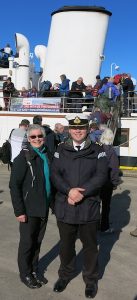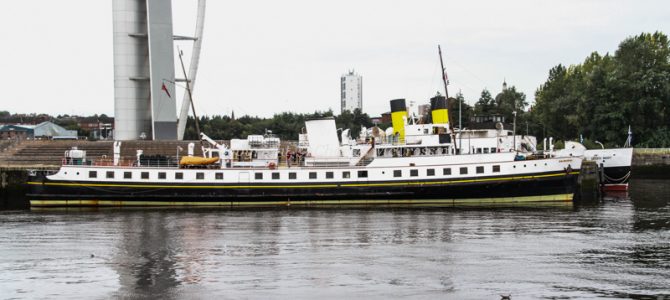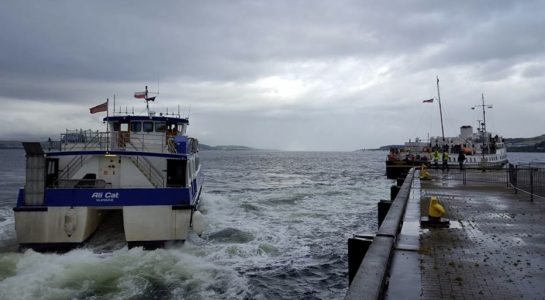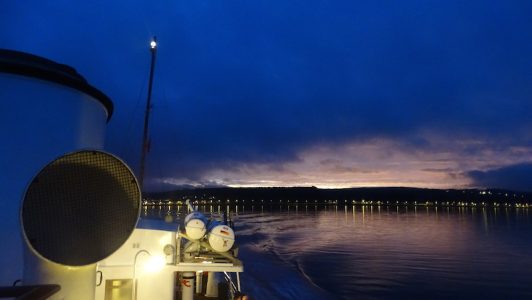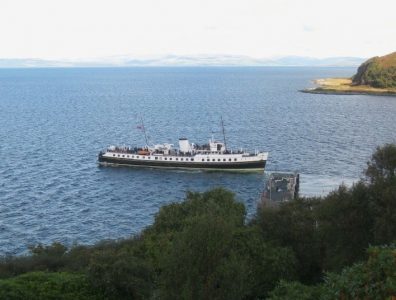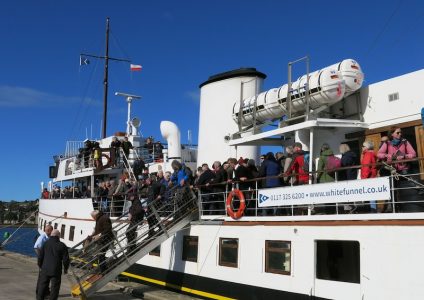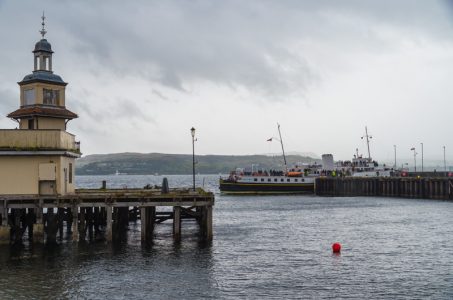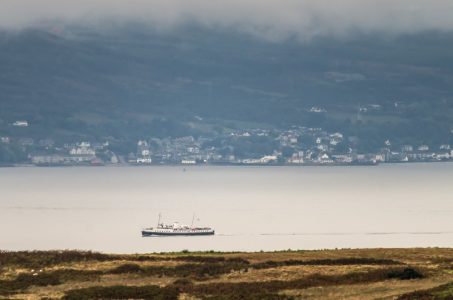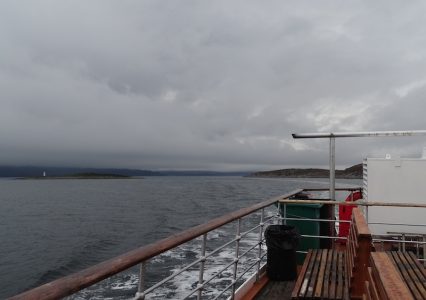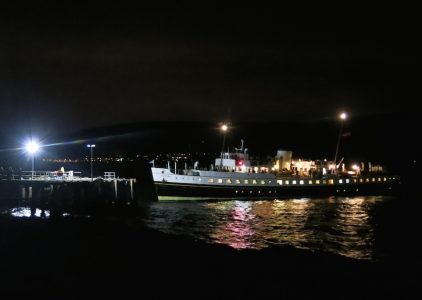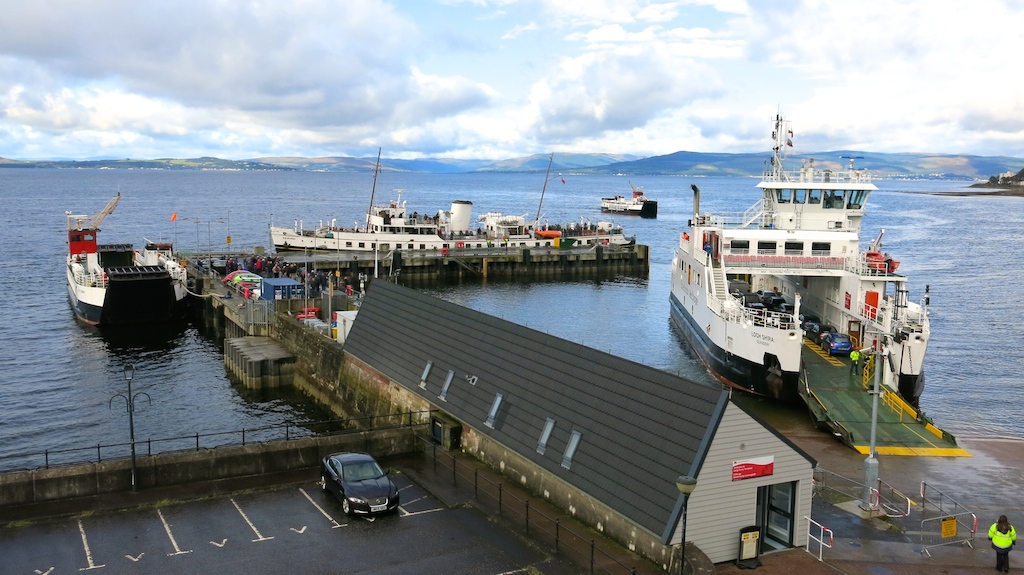
Balmoral at Largs on 21 September 2017, flanked by Loch Riddon, Loch Linnhe and Loch Shira. Copyright Andrew Clark
Allan Smith gives an upbeat assessment of Balmoral’s latest visit to the Clyde, during which her itinerary ranged from Greenock to Campbeltown, Glasgow to the Millport Illuminations and Helensburgh to the Kyles of Bute.
After Balmoral’s visit to the Western Isles in July, I was eagerly anticipating her return north for the September weekend on the Clyde. Admittedly, I had some concern that she might not make it back to Scotland after recent interruptions to her season on the Bristol Channel. Those concerns were put to rest on Wednesday 20 September when, after a morning charter from Liverpool to the Burbo Bank Offshore Wind Farm, she headed north up the Irish Sea.
My experience of both Waverley and Balmoral is limited to Scotland. I first sailed on the paddler when I was knee high and on Balmoral a little later: my clearest memory of that trip was getting a fright from the strange bell that sounded during the safety announcements.
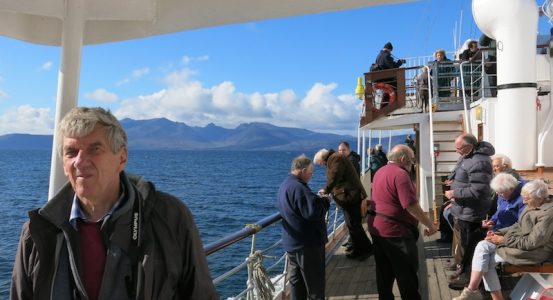
Richard Mills (left), director of White Funnel Ltd and Balmoral Fund trustee, pictured on the 21 September cruise to Lochranza and Campbeltown. He said that, while this year’s operation had been helped by some generous donations, investment in four key areas would be necessary to guarantee the ship’s future: crew accommodation, aft decking, engine overhaul and new generators. ‘We plan to bring her out again next summer. Whether that will be achievable, we don’t yet know.’ Copyright CRSC
Sailing overnight round the Mull of Galloway, Balmoral arrived on the Clyde in the early hours of Thursday 21 September and moored at Custom House Quay, Greenock, just after 7am. Less than two hours later her crew were welcoming passengers for the first cruise, to Lochranza and Campbeltown. We called at Helensburgh and proceeded down-firth to Largs, arriving appreciably late — despite departing both previous ports on time.
Leaving Loch Riddon, Loch Linnhe and Loch Shira at Largs, Balmoral continued south past Keppel where the local dolphin followed the ship. The aquatic mammal is a common sight from the decks of Waverley and the creature didn’t disappoint the 123 passengers on Balmoral. Our arrival at Lochranza was somewhat slow: getting the vessel balanced on the narrow face of the pier in a west wind was difficult but eventually the vessel settled at a slight angle. A handful disembarked for walks on Arran and about 30 joined for the sail down Kilbrannan Sound in beautiful sunshine.
Due to our late arrival at Campbeltown, we were given an extra 20 minutes ashore. On the return trip to Lochranza and Largs more dolphins were spotted in open waters, along with the resident dolphin at Keppel. In weather terms alone, this was easily the best day of the weekend, with sun shining for the majority of the cruise in the lower Firth, and you couldn’t mistake the general feeling of enjoyment aboard.
The following day I headed to Glasgow to join the ship for a sail down the river. Arriving at the Science Centre I found Balmoral positioning herself for the day’s cruise: she had just come from Greenock. She left on time with over 70 passengers and, given that the weather was nothing like as pleasant as the previous day, it was not surprising that numbers remained below 100 for the rest of the cruise.
Downriver, Balmoral passed the new Glen Sannox, currently in her latter stages of construction at Port Glasgow before launch in November, with her sister ship next to her but still to take proper shape. Balmoral arrived and departed Greenock around midday. On passing the container terminal, Captain David Howie gave one long and one short blast of the ship’s whistle to a vessel mooring at the terminal. The pilot onboard was believed to be one of Waverley and Balmoral’s former Masters, Captain Andy O’Brian. Balmoral then proceeded at full speed to Dunoon where the wind caused her almost as much trouble as it had Waverley earlier this summer.
At Rothesay the wind was quite strong coming off the pier. Balmoral first approached as if to berth port side alongside (i.e. facing west), as Waverley does, but after gauging the wind, Captain Howie decided to abort this and berth starboard side alongside, bringing us very close to the ferry linkspan. Once the ship had been secured, the next issue was discovered: the tide was exceptionally high, necessitating the use of the lower level doors to get passengers ashore, so a gangway was put ashore and the pier staff moved it to the forward ferry door. The gangway was left on the pier to await the vessel’s return.
During the cruise up Loch Striven the rain really closed in, so that not much could be seen, but passengers were still given the history of the area by the commentator, John Galloway. Recent diving activities had taken place regarding tests that were held on the loch for the miniature bouncing bombs known as “highball”.
Back at Rothesay the lower level was again used to transfer passengers, before the gangway was returned to the promenade deck. It is worth noting that on this cruise all three levels were used for the transfer of passengers, the bridge deck being preferred at Glasgow and the promenade deck at all other calls except Rothesay.
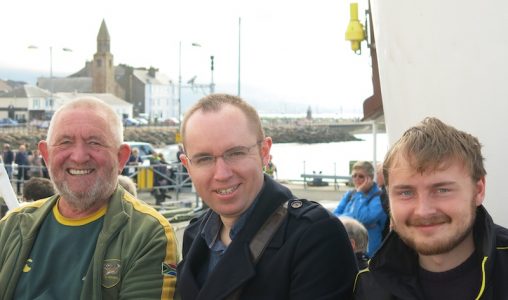
Allan Smith (right) on 25 September with two former Balmoral/Waverley Pursers — Jim McFadzean and Paul Semple. Copyright CRSC
For the return call at Dunoon we approached from the north. Then, departing for Greenock and Glasgow, Balmoral swung on the knuckle of the breakwater until she was pointing roughly east and we left simultaneously with Ali Cat — whereupon a short race ensued, with Balmoral gradually leaving the Argyll Ferries catamaran behind.
On Saturday 23 September there was a unique moment at the Science Centre when Balmoral moved forward on the berth to position her bow close to that of T.S. Queen Mary. During a short ceremony the Masters of the two vessels exchanged gifts on behalf of their respective charities.
This was Millport Illuminations day. Balmoral left Glasgow at 3pm and called at Greenock, Helensburgh, Dunoon and Largs, before heading south for her first-ever call at Keppel. This gave passengers the choice of disembarking to watch the fireworks display from the shore or staying aboard to admire the Illuminations from a seaward vantage point. With around 220 aboard, it was the most popular cruise of Balmoral’s weekend itinerary. Berthing at Keppel took some time, with two attempts being made on outward and return calls, and on each occasion she departed astern. She began her return journey punctually at 9pm, and there were none of the disorderly scenes and latecomers that characterised Illuminations cruises in the past. Nevertheless, the ship arrived back at Glasgow nearly an hour behind schedule, just before 2am.
For Sunday’s cruise, accompanied by low cloud throughout, I boarded at Largs from where Balmoral proceeded via Rothesay and Tighnabruaich to Tarbert. All calls went as planned apart from Tarbert, where another exceptionally high tide resulted in the ferry door (‘the Lundy level’) being used once again for disembarkation. Only one passenger joined the vessel at Tarbert for the cruise up Loch Fyne.
On our departure the disabled Isle of Cumbrae could be seen in the inner harbour while Loch Linnhe catered for the Portavadie service. When Balmoral’s 2017 season was originally advertised, the itinerary included a call at Ardrishaig, but the pier was later declared unsuitable and a cruise to Otter Narrows was substituted. On our return to Tarbert, passenger transfers took place from the promenade deck. After the return call at Tighnabruaich, Rothesay was reached in fading light and looked really beautiful.
Heading from Rothesay to Largs was a treat. Looking back from the bridge deck, the sight of Balmoral’s funnel profiled against the setting sun over Bute was breathtaking. The departure from Largs after sunset was also a joy to watch as Balmoral passed south of Loch Shira, which was returning from Cumbrae Slip.
Balmoral’s last sail of the September weekend, on Monday 25th, was cut short due to some of the thickest fog seen on the Clyde in recent years. Upon departure from Glasgow, with around 50 passengers, visibility was a little bit below normal, but this did not persist for long. By the time we were off Wemyss Bay the sun was out in force and a large group of enthusiasts and day trippers joined the vessel at Largs.
After calling at Rothesay, where we gained a reasonable helping of passengers, Balmoral set off for her cruise round Bute, but after passing through the Narrows we met a large wall of fog roughly parallel to Tighnabruaich (see Fog on the Clyde).
Captain Howie informed passengers he would have to start ‘sound signalling’ in accordance with International Regulations for the Prevention of Collision at Sea. The sound signal for a vessel underway while in or near an area of restricted visibility is one long blast every two minutes. On most modern vessels, a switch can turn this signal on to allow it to repeat automatically. On Balmoral it must be done manually. Captain Howie showed great care for passengers as he forewarned those on the foredeck every time he had to use the ship’s whistle.
After passing Tighnabruaich the fog lifted and all seemed well — until we ventured further down the West Kyle. Looking south, another wall of fog could be seen. Balmoral slowed and the sound signalling started.
With our scheduled arrival time at Rothesay now looking increasingly under threat, the Master contacted one of CalMac’s Arran vessels for a weather report from Ardrossan Harbour. This confirmed that visibility was down to a tenth of a mile — and so at 3.30pm Captain Howie made the decision to double back and pay a visit to Loch Striven. At the Narrows, we encountered a yacht lingering in our path. Five short and rapid blasts were given as a request of “What is your intention?” — and the yacht duly moved out of the way. We did not venture far up Loch Striven before returning to Rothesay.
After leaving Bute for the last time, it wasn’t long before Balmoral was sound signalling again. We reduced speed initially to about eight knots and then to four as we became enveloped in fog. When Largs Pier eventually emerged, the effect was quite eerie, as the rest of the seafront remained invisible. Given how close the pier is to the rest of the town, you can imagine the extent of the fog.
The Master and Purser made several announcements highlighting the likelihood of a very late arrival at the remaining calls and suggesting people take the train if they wished a more certain arrival time. This became the only option after Captain Howie contacted Western Ferries for a report on visibility up-firth, where it was said to be less than 100 metres — similar to Largs. With this information, the Captain took the decision to cancel the rest of the cruise, and train fares would be reimbursed to anyone requiring the train home. All passengers disembarked and left the vessel at a misty Largs Pier.
This brought Balmoral’s Clyde season to an abrupt but exciting end. Let’s hope she is fit for duty next year and once again navigates the Clyde for our pleasure and entertainment.
Balmoral’s 2017 season ends with sailings on the Bristol Channel from 4th to 9th October. Book online here or call 0117 325 6200 (Monday-Friday 10am-4pm)
A PICTORIAL GALLERY OF BALMORAL’S SEPTEMBER WEEKEND SAILINGS ON THE CLYDE
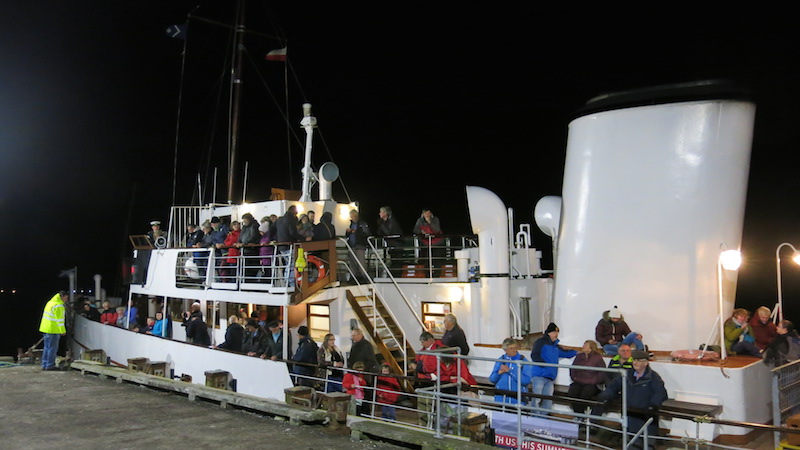
Balmoral prepares to leave Keppel at 9pm on 23 September 2017 for the return voyage to Glasgow. Copyright Andrew Clark
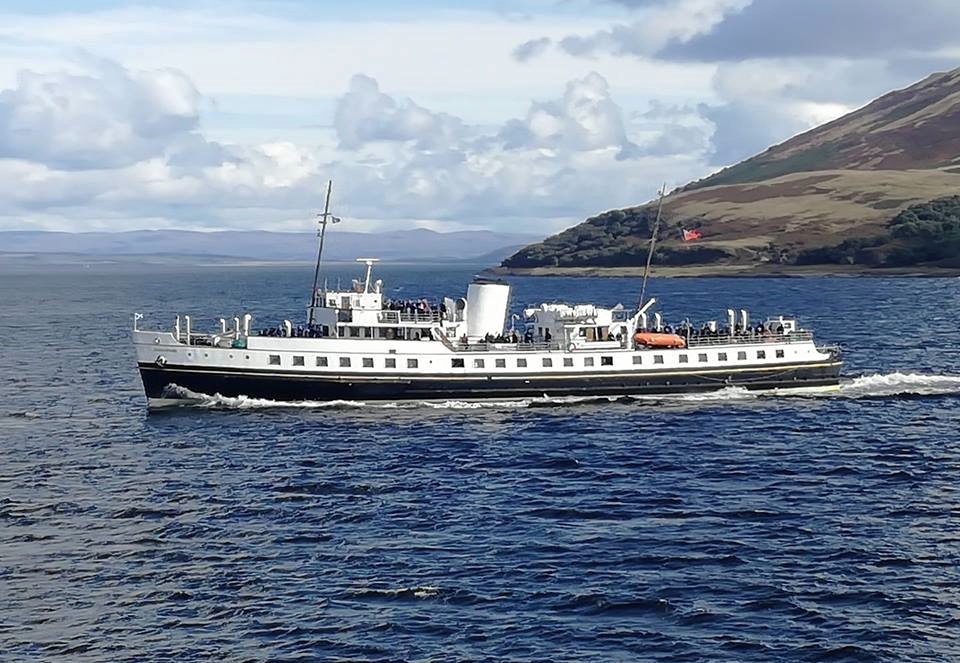
Pictured from CalMac ferry Catriona off Lochranza, Balmoral heads for Campbeltown on 21 September 2017. Copyright Jim Mcmath
Balmoral on the Clyde —‘a good experience’












